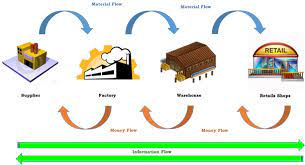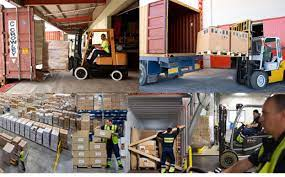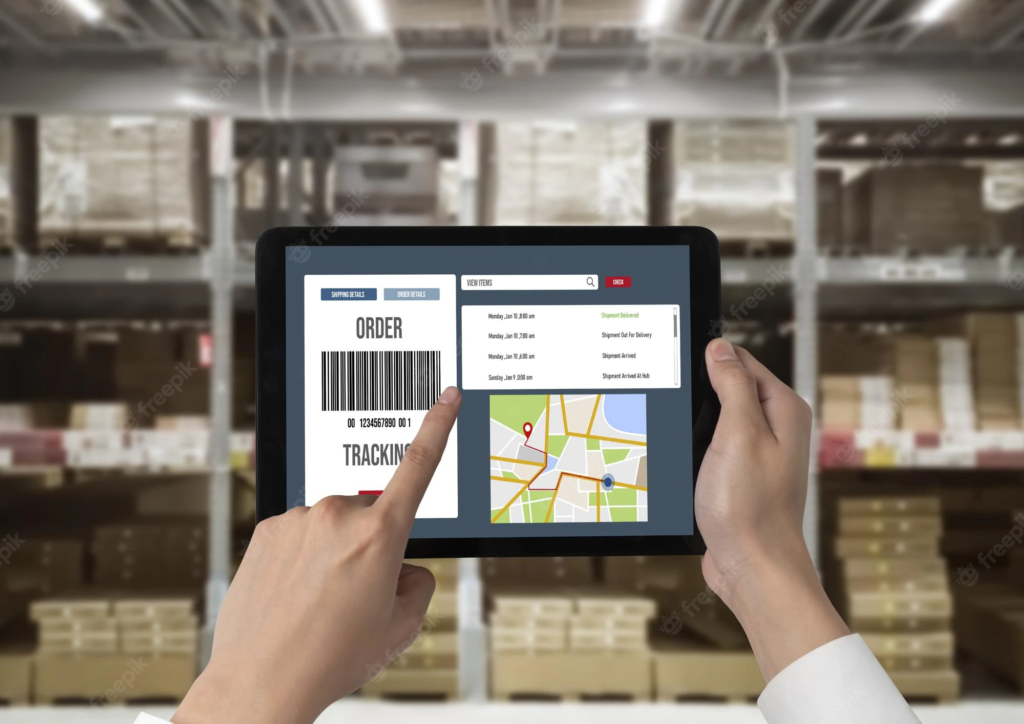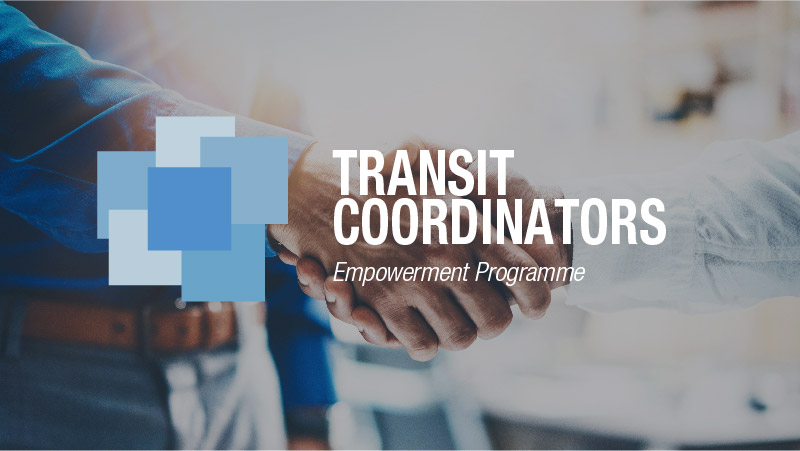Consignment Tracking Executive (1 years diploma)
Consignment Tracking Executive click here
Brief Job Description
Consignment Tracking Executives are also known as Consignment Trackers or Consignment Tracking
Clerks. Individuals in this role are responsible for tracking each consignment at regular intervals as it
moves from origin to its destination along the suggested route. They coordinate with the truck driver,
transport companies and transport authorities to update real time information on the system.

Personal Attributes
This job requires the individual to work well with his/her team and achieve joint goals. The individual must
be able to prioritize and execute tasks within scheduled time limits. The individual should be able to
maintain high concentration levels throughout his/her shift.
Prepare For Tracking
Description
This unit is about preparing for tracking.
Elements and Performance Criteria
Obtain all the necessary information
To be competent, the user/individual on the job must be able to:
PC1. obtain the work schedule, the list of trucks to be tracked for the day from the transport
manager.
PC2. obtain the lorry receipts (lrs) from the consignment booking assistant and understand the
details pertaining to each consignment.
PC3. find out if there is any trouble/natural disaster along any of the routes.
PC4. understand the status and priorities or special conditions (if any) among the consignments
from the consignment tracking executive of the previous shift.
Prepare computer and tracking systems
To be competent, the user/individual on the job must be able to:
PC5. switch on the computer and login using using company credentials.
PC6. check and ensure that the telephone, computer and tracking systems like gps are working
well without any issues.
PC7. ensure that any stationery required like paper, pens, etc. are available to quickly note down
information if required.
PC8. have the list with the contact details of the trucking companies, checkposts, local authorities,
etc. ready for easy reference
PC9. make sure any issues/problems are solved before starting work.
Knowledge and Understanding (KU)
The individual on the job needs to know and understand:
KU1. types of documentation used in organization and importance of the same
KU2. risk and impact of not following defined work, safety and security procedures
KU3. records to be maintained and the importance of the same
KU4. security procedures to be followed
KU5. escalation matrix for reporting identified problems
KU6. chain of command for reporting problems
KU7. knowledge of how the company deals with issues while transporting consignments
KU8. knowledge of transit rules and regulations.
KU9. knowledge of various clients and their requirements
KU10. implications of poor performance such as delayed pick-up, improper documentation and high
error rate
KU11. an end to end understanding of all activities that will be done.
KU12. nature of the products transported and the variances in their characteristics
KU13. detailed understanding of the tracking systems
KU14. ability to accurately estimate travel time required
KU15. understanding of common problems and solutions for the same
KU16. basic computer and system skills to operate and perform minor fixes
KU17. knowledge of processes and differences in processes across clients/products
KU18. knowledge of routes and ability to reroute if required
KU19. knowledge of controls and processes for operating computer terminal
KU20. ability to anticipate problems.
Generic Skills (GS)
User/individual on the job needs to know how to:
GS1. ability to make note of instructions for the relieving consignment tracking executive
GS2. ability to develop operating procedures, improvements and create documents for internal
understanding/use
GS3. good reading skills, ability to comprehend written instructions, standard operating
procedures
GS4. read and understand documents required for all operational activities
GS5. read and understand instructions on how to use the tracking systems.
GS6. communicate well with people of all levels
GS7. communicate with client/warehouse coordinators/internal staff effectively
GS8. share experiences and provide guidance to juniors and peers
GS9. act objectively , rather than impulsively or emotionally when faced with difficult/stressful or
emotional situations
GS10. ability to make a judgment as to whether an issue is to serious enough to be escalated or
not.

GS11. adjust according to volume, capacity and manpower needs during peak and non-peak hours
GS12. prioritize and execute tasks within the scheduled time limits
GS13. maintain schedules and punctuality. avoid absenteeism.
GS14. be a team player and achieve joint goals
GS15. flexibility to re-assess schedule in case of delays/additional orders
GS16. understand the customer timelines and ensure that they are met.
GS17. identify trends/common causes for errors and suggest possible solutions to the transport
manager
GS18. handle day to day problems like delays, staffing shortage, etc
GS19. suggest methods to streamline the tracking process.
GS20. ability to keep track of the progress of each truck in real time
GS21. ability to concentrate on task at hand and complete it without errors
Track Consignments
Description
This OS unit is about tracking consignments
Elements and Performance Criteria
Monitor status of each consignment
To be competent, the user/individual on the job must be able to:
PC1. use the details provided in the lr and check on each consignment using the system
PC2. check whether the truck is on the right route as specified in the system.
PC3. determine whether the truck has covered sufficient distance and would reach the destination
on time
PC4. find out if there has been any route changes or any other changes in paperwork for any
consignment in the system and note it down to inform the driver. identify and note down any
truck that has reported any issues/problems/delays in the system.
PC5. identify and note down any truck that has reported any issues/problems/delays in the system
and accordingly inform the supervisor for any other alternate arrangements.
Check in with driver, authorities and report issues
To be competent, the user/individual on the job must be able to:
PC6. call up the drivers of the trucks that have not reported any information
PC7 . if the driver is not reachable, determine where the truck should be at the moment. backtrack
journey based on any previous information
PC8. check with check post officials and transport authorities whether the truck passed through
the check post and when.
PC9. note down any information obtained
PC10. for trucks that had reported delays or problems, call up the driver and understand the cause
PC11. if it is a normal reason (like flat tire, fuels stop, etc.), find out from the driver when the
journey would resume and note it down.
PC12. if there is any technical issue which the driver would not be able to handle, arrange to have
the nearest technical service providers provide assistance
PC13. if there are any other reasons like documentation problems or accidents, escalate it to the
transport coordinator or the transport manager
PC14. remind drivers of route changes/special weather conditions if any and make sure that they
are aware of it.
PC15. update transport manager / outbound team / customer in case of any delays.
PC16. note down any trucks that have not reported any information and raise flags in the system to
follow up on.
Knowledge and Understanding (KU)
The individual on the job needs to know and understand:
KU1. types of documentation used in organization and importance of the same
KU2. risk and impact of not following defined work, safety and security procedures
KU3. records to be maintained and the importance of the same
KU4. security procedures to be followed
KU5. escalation matrix for reporting identified problems
KU6. chain of command for reporting problems
KU7. knowledge of how the company deals with issues while transporting consignments
KU8. knowledge of transit rules and regulations.
KU9. knowledge of various clients and their requirements
KU10. implications of poor performance such as delayed pick-up, improper documentation and high
error rate
KU11. an end to end understanding of all activities that will be done.
KU12. nature of the products transported and the variances in their characteristics
KU13. detailed understanding of the tracking systems
KU14. ability to accurately estimate travel time required

KU15. understanding of common problems and solutions for the same
KU16. basic computer and system skills to operate and perform minor fixes
KU17. knowledge of processes and differences in processes across clients/products
KU18. knowledge of routes and ability to reroute if required.
KU19. knowledge of controls and processes for operating computer terminal
KU20. ability to anticipate problems
Generic Skills (GS)
User/individual on the job needs to know how to:
GS1. ability to make note of instructions for the relieving consignment tracking executive
GS2. ability to develop operating procedures, improvements and create documents for internal
understanding/use
GS3. good reading skills, ability to comprehend written instructions, standard operating
procedures
GS4. read and understand documents required for all operational activities
GS5. read and understand instructions on how to use the tracking systems.
GS6. communicate well with people of all levels
GS7. communicate with client/warehouse coordinators/internal staff effectively
GS8. share experiences and provide guidance to juniors and peers
GS9. act objectively , rather than impulsively or emotionally when faced with difficult/stressful or
emotional situations
GS10. ability to make a judgment as to whether an issue is to serious enough to be escalated or not
GS11. adjust according to volume, capacity and manpower needs during peak and non-peak hours
GS12. prioritize and execute tasks within the scheduled time limits
GS13. maintain schedules and punctuality. avoid absenteeism.
GS14. be a team player and achieve joint goals
GS15. flexibility to re-assess schedule in case of delays/additional orders
GS16. understand the customer timelines and ensure that they are met.
GS17. identify trends/common causes for errors and suggest possible solutions to the transport
manager.
GS18. handle day to day problems like delays, staffing shortage, etc.
GS19. suggest methods to streamline the tracking process.
GS20. ability to keep track of the progress of each truck in real time.
GS21. ability to concentrate on task at hand and complete it without errors
Perform Post Tracking Activities
Description
This unit is about performing post tracking activities
Elements and Performance Criteria
Update consignment information in the system
To be competent, the user/individual on the job must be able to:
PC1. input the location of each consignment, reasons for delays if any and other issues.
PC2. based on progress, update the expected arrival time
PC3. coordinate with the technical support providers to ensure that they reach the truck and
provide service.
PC4. check with drivers at regular intervals to find out if the problems have been resolved and
that the journey has resumed.
PC5. update the information in the system at regular intervals
PC6. make sure all the flagged consignments which had not reported progress have been followed
up on.
PC7. if any consignment could not be tracked through call or by the authorities, escalate it to the
transport manager as priority.
PC8. close the order in the system if it has reached its destination
Report to management

To be competent, the user/individual on the job must be able to:
PC9. inform the transport manager about any delays, issues with authorities, etc.
PC10. report any issues faced in contacting drivers or inability to track a particular consignment
during the shift.
PC11. prepare reports on the troublesome routes, reasons for delays, etc.
Log off computer, clean up and handover shift
To be competent, the user/individual on the job must be able to:
PC12. save all data, safely log off and switch off the computer
PC13. dispose any unnecessary documents or papers.
PC14. clean up the work area for shift handover.
PC15. brief the relieving consignment tracking executive about the important happening of the
shift and the work to be done in the next shift.
Knowledge and Understanding (KU)
The individual on the job needs to know and understand:
KU1. types of documentation used in organization and importance of the same
KU2. risk and impact of not following defined work, safety and security procedures
KU3. records to be maintained and the importance of the same
KU4. security procedures to be followed
KU5. escalation matrix for reporting identified problems
KU6. chain of command for reporting problems
KU7. knowledge of how the company deals with issues while transporting consignments
KU8. knowledge of transit rules and regulations
KU9. knowledge of various clients and their requirements
KU10. implications of poor performance such as delayed pick-up, improper documentation and high
error rate
KU11. an end to end understanding of all activities that will be done.
KU12. nature of the products transported and the variances in their characteristics
KU13. detailed understanding of the tracking systems
KU14. ability to accurately estimate travel time required
KU15. understanding of common problems and solutions for the same
KU16. basic computer and system skills to operate and perform minor fixes
KU17. knowledge of processes and differences in processes across clients/products
KU18. knowledge of routes and ability to reroute if required
KU19. knowledge of controls and processes for operating computer terminal
KU20. ability to anticipate problems.
Generic Skills (GS)
User/individual on the job needs to know how to:
GS1. ability to make note of instructions for the relieving consignment tracking executive.
GS2. ability to develop operating procedures, improvements and create documents for internal
understanding/use
GS3. good reading skills, ability to comprehend written instructions, standard operating
procedures
GS4. read and understand documents required for all operational activities
GS5. read and understand instructions on how to use the tracking systems
GS6. communicate well with people of all levels
GS7. communicate with client/warehouse coordinators/internal staff effectively
GS8. share experiences and provide guidance to juniors and peers
GS9. act objectively , rather than impulsively or emotionally when faced with difficult/stressful or
emotional situations
GS10. ability to make a judgment as to whether an issue is to serious enough to be escalated or not
GS11. adjust according to volume, capacity and manpower needs during peak and non-peak hours
GS12. prioritize and execute tasks within the scheduled time limits
GS13. maintain schedules and punctuality. avoid absenteeism.
GS14. be a team player and achieve joint goals
GS15. flexibility to re-assess schedule in case of delays/additional orders
GS16. understand the customer timelines and ensure that they are met.
GS17. identify trends/common causes for errors and suggest possible solutions to the transport
manager
GS18. handle day to day problems like delays, staffing shortage, etc.
GS19. suggest methods to streamline the tracking process
GS20. ability to keep track of the progress of each truck in real time.
GS21. ability to concentrate on task at hand and complete it without error
Maintain Health, Safety and Security measures while tracking consignments
Description
This unit is about health and safety measures
Elements and Performance Criteria
Maintain health, safety and security measures during all activities
To be competent, the user/individual on the job must be able to:
PC1. follow all security procedures as per company policy
PC2. follow all precautionary data handling procedures
PC3. maintain clean work table area.
PC4. ensure data privacy and independence in all dealings
PC5. recognize and report unsafe conditions and practices
PC6. in case of signs of any emergency situation or accident or breach of safety immediately
follow organizational protocol to deploy action
PC7. identify reasons for occurrence of incident
PC8. capture reasons and response/action taken into incident report/note to manager
PC9. report any deviations from standard protocol along with reasons (if any)
PC10. visually inspect the activity area and equipment for appropriate and safe condition.

Knowledge and Understanding (KU)
The individual on the job needs to know and understand:
KU1. types of documentation used in organization and importance of the same
KU2. risk and impact of not following defined work, safety and security procedures
KU3. records to be maintained and the importance of the same
KU4. security procedures to be followed
KU5. escalation matrix for reporting identified problems
KU6. chain of command for reporting problems
KU7. knowledge of how the company deals with issues while transporting consignments
KU8. knowledge of transit rules and regulations.
KU9. knowledge of various clients and their requirements
KU10. implications of poor performance such as delayed pick-up, improper documentation and high
error rate
KU11. an end to end understanding of all activities that will be done.
KU12. nature of the products transported and the variances in their characteristics
KU13. detailed understanding of the tracking systems
KU14. ability to accurately estimate travel time required
KU15. understanding of common problems and solutions for the same
KU16. basic computer and system skills to operate and perform minor fixes
KU17. knowledge of processes and differences in processes across clients/products
KU18. knowledge of routes and ability to reroute if required.
KU19. knowledge of controls and processes for operating computer terminal
KU20. ability to anticipate problems.
Generic Skills (GS)
User/individual on the job needs to know how to:
GS1. ability to make note of instructions for the relieving consignment tracking executive.
GS2. ability to develop operating procedures, improvements and create documents for internal
understanding/use
GS3. good reading skills, ability to comprehend written instructions, standard operating
procedures
GS4. read and understand documents required for all operational activities
GS5. read and understand instructions on how to use the tracking systems.
GS6. communicate well with people of all levels
GS7. communicate with client/warehouse coordinators/internal staff effectively
GS8. share experiences and provide guidance to juniors and peers
GS9. act objectively , rather than impulsively or emotionally when faced with difficult/stressful or
emotional situations
GS10. ability to make a judgment as to whether an issue is to serious enough to be escalated or
not.
GS11. adjust according to volume, capacity and manpower needs during peak and non-peak hours
GS12. prioritize and execute tasks within the scheduled time limits
GS13. maintain schedules and punctuality. avoid absenteeism.
GS14. be a team player and achieve joint goals
GS15. flexibility to re-assess schedule in case of delays/additional orders
GS16. understand the customer timelines and ensure that they are met.
GS17. identify trends/common causes for errors and suggest possible solutions to the transport
manager
GS18. handle day to day problems like delays, staffing shortage, etc
GS19. suggest methods to streamline the tracking process.
GS20. ability to keep track of the progress of each truck in real time
GS21. ability to concentrate on task at hand and complete it without errors
Employability Skills (30 Hours)
Description
This unit is about employability skills, Constitutional values, becoming a professional in the 21st Century,
digital, financial, and legal literacy, diversity and Inclusion, English and communication skills, customer
service, entrepreneurship, and apprenticeship, getting ready for jobs and career development.
Scope
The scope covers the following :
Introduction to Employability Skills
Constitutional values – Citizenship
Becoming a Professional in the 21st Century
Basic English Skills
Communication Skills
Diversity & Inclusion
Financial and Legal Literacy
Essential Digital Skills
Entrepreneurship
Customer Service
Getting ready for Apprenticeship & Jobs
Elements and Performance Criteria
Introduction to Employability Skills
To be competent, the user/individual on the job must be able to:
PC1. understand the significance of employability skills in meeting the job requirements
Constitutional values – Citizenship
To be competent, the user/individual on the job must be able to:
PC2. identify constitutional values, civic rights, duties, personal values and ethics and
environmentally sustainable practices
Becoming a Professional in the 21st Century
To be competent, the user/individual on the job must be able to:
PC3. explain 21st Century Skills such as Self-Awareness, Behavior Skills, Positive attitude, selfmotivation, problem-solving, creative thinking, time management, social and cultural
awareness, emotional awareness, continuous learning mindset etc.
Basic English Skills
To be competent, the user/individual on the job must be able to:
PC4. speak with others using some basic English phrases or sentences
Communication Skills
To be competent, the user/individual on the job must be able to:
PC5. follow good manners while communicating with others
PC6. work with others in a team
Diversity & Inclusion
To be competent, the user/individual on the job must be able to:
PC7. communicate and behave appropriately with all genders and PwD
PC8. report any issues related to sexual harassment
Financial and Legal Literacy
To be competent, the user/individual on the job must be able to:
PC9. use various financial products and services safely and securely
PC10. calculate income, expenses, savings etc.
PC11. approach the concerned authorities for any exploitation as per legal rights and laws
Essential Digital Skills
To be competent, the user/individual on the job must be able to:
PC12. operate digital devices and use its features and applications securely and safely
PC13. use internet and social media platforms securely and safely
Entrepreneurship
To be competent, the user/individual on the job must be able to:
PC14. identify and assess opportunities for potential business
PC15. identify sources for arranging money and associated financial and legal challenges
Customer Service
To be competent, the user/individual on the job must be able to:
PC16. identify different types of customers
PC17. identify customer needs and address them appropriately
PC18. follow appropriate hygiene and grooming standards
Getting ready for apprenticeship & Jobs
To be competent, the user/individual on the job must be able to:
PC19. create a basic biodata

PC20. search for suitable jobs and apply
PC21. identify and register apprenticeship opportunities as per requirement
Knowledge and Understanding (KU)
The individual on the job needs to know and understand:
KU1. need for employability skills
KU2. various constitutional and personal values
KU3. different environmentally sustainable practices and their importance
KU4. Twenty first (21st) century skills and their importance
KU5. how to use basic spoken English language
KU6. Do and dont of effective communication
KU7. inclusivity and its importance
KU8. different types of disabilities and appropriate communication and behaviour towards PwD
KU9. different types of financial products and services
KU10. how to compute income and expenses
KU11. importance of maintaining safety and security in financial transactions
KU12. different legal rights and laws
KU13. how to operate digital devices and applications safely and securely
KU14. ways to identify business opportunities
KU15. types of customers and their needs
KU16. how to apply for a job and prepare for an interview
KU17. apprenticeship scheme and the process of registering on apprenticeship portal
Generic Skills (GS)
User/individual on the job needs to know how to:
GS1. communicate effectively using appropriate language
GS2. behave politely and appropriately with all
GS3. perform basic calculations
GS4. solve problems effectively
GS5. be careful and attentive at work
GS6. use time effectively
GS7. maintain hygiene and sanitisation to avoid infection







